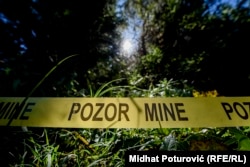TUZLA, Bosnia-Herzegovina -- It's been more than two decades since the war in Bosnia-Herzegovina ended, but Plamenko Priganica knows the enemy still lurks in the Majevica hills near his home in Tuzla.
Priganica is one of the thousands to have become a victim of land mines planted during the 1992-95 conflict that tore the country -- and the former Yugoslavia -- apart at its ethnic seams.
"The killer is still waiting 25 years after the war," the 57-year-old, who lost his left leg below the knee, told RFE/RL from his home.
The Bosnian government’s Mine Action Strategy for 2009-19 was supposed to put an end to the fears of Priganica and the half a million other Bosnians who live in or around areas where leftover mines remain. Instead, the fields and forests where many still scavenge for wild strawberries and mushrooms are still littered with explosives.
The 2019 target set out in the strategy for clearing all remaining ordnance will be missed by several years, according to the Bosnia-Herzegovina Mine Action Center (BHMAC), amid a funding shortfall and political inaction.
By 2013, the center estimates that less than half of the funding needed for projects was realized, a percentage that has fallen since then. While part of the problem, BHMAC says, is a decrease in donor funding, the greater issue is with government contributions to the program.
"In looking at the 2009-19 strategy, we are lagging behind by about four years. There is a new strategy and under this strategy Bosnia and Herzegovina will be clean from mines by 2025," says Miodrag Gajic, an information officer at the center.
Accidents are common in this line of work. They usually leave deminers severely physically disabled, although fatalities are less frequent."-- Nail Hujic of INTERSOS
BHMAC estimates that while around 2,900 square kilometers of land have been cleared of explosive materials, just over 1,000 square kilometers of Bosnia -- or about 2.2 percent of the country -- is still polluted by mines. Nearly 600 people have been killed by mines or unexploded bombs since the war ended and more than 1,100 others have been injured, according to the center.
The highest-risk zones are often forests where the front lines that separated warring factions once ran. These include municipalities such as Velika Kladusa, Orasje, and Doboj.
In March, a farmer in Tulic, near the city of Tuzla, was dragging firewood from a forest when his tractor hit a mine. The blast killed the driver.
Nizam Cancar, a deminer who lost his leg to an explosive device in 1994 during the war, says it’s easy for such accidents to happen.
Years of harsh weather conditions have muddled what few maps authorities have of mined areas. Devices, he says, can shift under such conditions, making a dangerous situation even more treacherous.
"It's very difficult to find them. If you put them in a particular place 20 years ago, they are no longer there. It could move a meter or two in any direction," he says.
The problem of land mines in Bosnia once attracted international attention.
This past summer marked the 20th anniversary of Princess Diana's visit to Bosnia as part of her crusade against land mines. In her last overseas trip before she died in a Paris car crash in 1997, Diana met with victims in the small village of Dobrnja, near Tuzla.
One of those Diana met was Mirzeta Gabeljic.
In 1997, Gabeljic was a 15-year-old schoolgirl returning home when she stepped on a land mine. The blast took her right leg below the knee.
Like many victims, she has struggled since her accident, given the limited resources available from the state for amputees, although now she is looking to start the country’s first sitting volleyball club for women.
According to Priganica, the provision of orthopedic supplies have not improved in the 25 years since the war.
"They can be purchased abroad, but they are very expensive," he says.
Adding to the problem is that the large number of humanitarian organizations that worked here after the war have left, he claims, "because the focus of their interest has moved somewhere else."
Bosnia emerged from the breakup of the former Yugoslavia as Europe’s poorest country, with gross domestic product per capita at 28 percent of the European average. Unemployment is high and corruption rampant, stunting the development of social services for large swaths of the country.
Considering the tough economic times Bosnia currently faces, BHMAC’s Gajic hopes that help from other countries will once again increase.
"Within our new strategy, we plan to have a donor conference in mid-November. This is a date where I hope we will have more bountiful donor funds," he says.
Time is also of the essence for a task that is painstakingly slow.
Deminers try to work eight-hour shifts, but the task is so intense and angst-ridden that they must take breaks every 30 minutes to remain focused.
Squatting and searching the ground while wearing protective suits that can weigh up to 25 kilograms, deminers probe about 2,500 times just to check just 1 square meter of ground. On a good day, they will cover 50 square meters, according to Nail Hujic, a technical director at INTERSOS, a nonprofit humanitarian aid organization.
The deminers, he says, must constantly assess the type of munition they may have to deal with, how it is placed in the ground, and even the possibility of deliberate traps laid by whoever planted the land mine.
"The result of all this, as well as of inadequate equipment and mental and physical fatigue among deminers, is frequent accidents," Hujic says. "Unfortunately, we have to say that accidents are common in this line of work. They usually leave deminers severely physically disabled, although fatalities are less frequent."
Even if foreign donors pony up the funds needed to jump-start the clearing program, the money will come too late for Asim Kudra, who lost his uncle to a land mine when he returned home after the war to Zlatiste, near Sarajevo.
Kudra says the area was demined, but residents still live in fear.
"You cannot say that it is safe for certain, because it isn't," he says.











